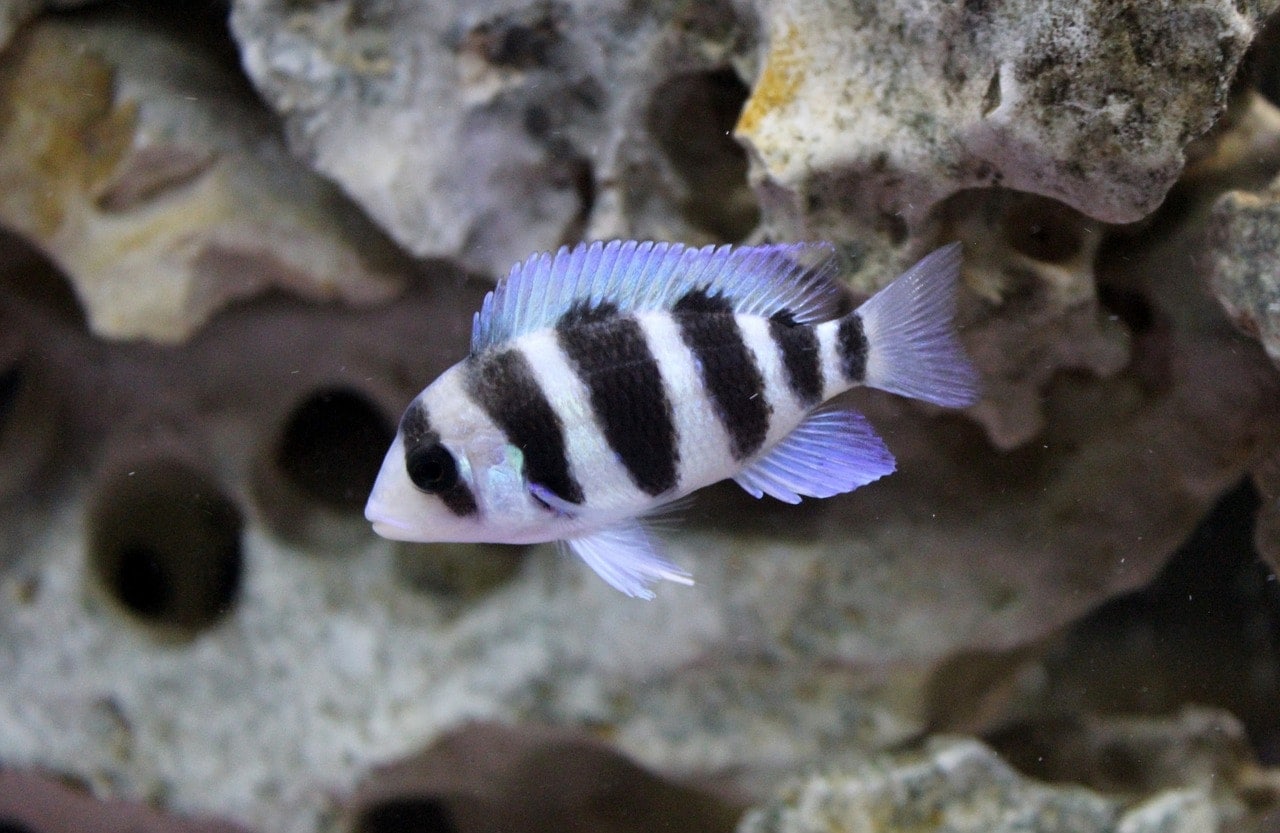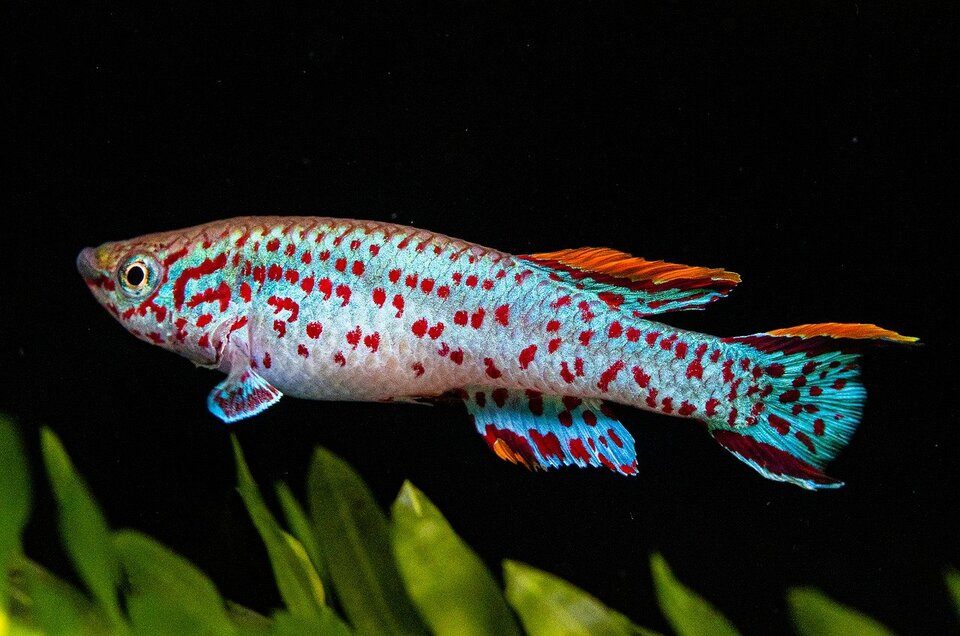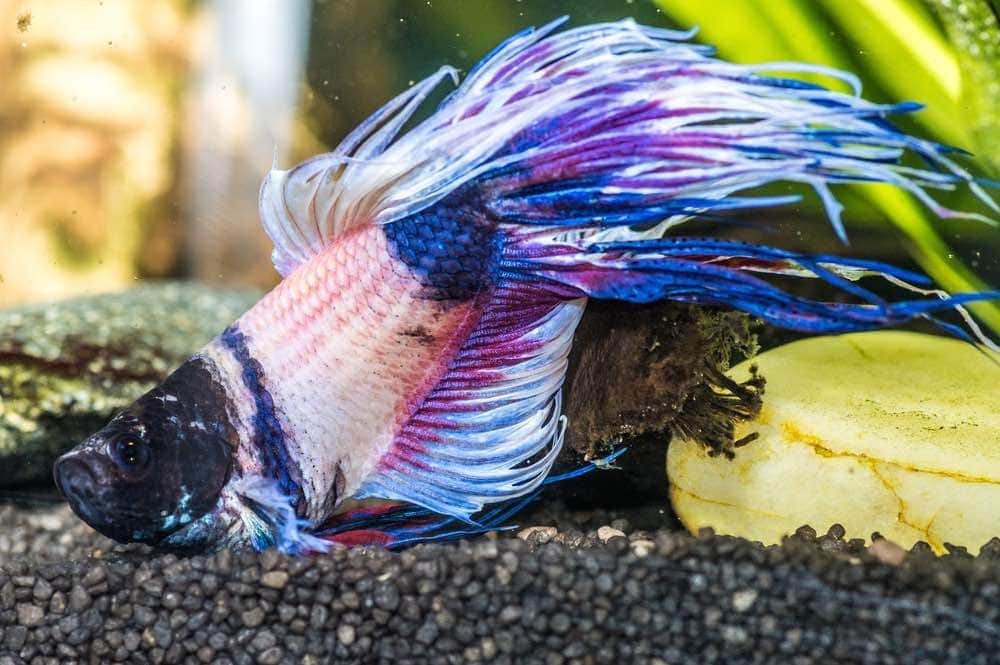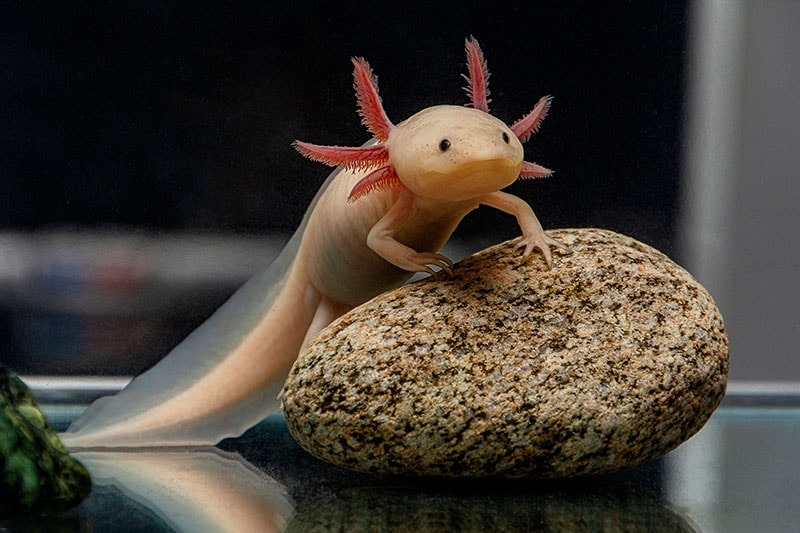Top 9 Rocks For Cichlid Tanks in 2024 – Reviews & Top Picks

Updated on

Rocks are an integral part to a happy Cichlid community. They use rocks for play, to get cover from other fish, for privacy, and for spawning young fish too, so it’s important to get the best rocks for your Cichlid tank. However, the hard part is finding the right rocks (this is our top pick). This is a little tricky as there are many options to go with, but that is why we are here.
We’re going to talk all about rocks for aquariums and for Cichlid tanks specifically, as well, we have the top nine safe Cichlid rock options for you to take a look at.
A Comparison of Our Favorites in 2024
| Rating | Image | Product | Details | |
|---|---|---|---|---|
| Best Overall |

|
MF CICHLID STONE Ceramic Aquarium Rock Cave Decor |
|
Check Price |
| Best Value |

|
Pisces Seiryu Rock |
|
Check Price |
| Premium Choice |

|
Texas Holey Rock Honeycomb Limestone |
|
Check Price |

|
Underwater Galleries Cichlid Stones |
|
Check Price | |

|
Penn-Plax Deco-Replicas |
|
Check Price |
The 9 Best Rocks for Cichlid Tanks
In our eyes there is a clear winner here and yes it is a fake rock. The takeaway here is that you might never know exactly what real rocks contain, especially when you find them yourself. A nice fake rock is a perfect way to go in order to ensure the safety of your Cichlids.
1. CORISRX Ceramic Aquarium Rock Cave Decor
This is a ceramic rock cave for your Cichlids. It is not only for Cichlids, but they will certainly love it. It has a smooth surface that can act as a good breeding ground for your fish, both on the inside and outside.
The cave itself is fairly large and will easily accommodate several Cichlids, making it perfect for breeding and spawning. It makes for a really nice smooth and natural environment, the same kind which these fish would have in the wild. This item will make for good shelter for all of your fish, shrimp, and even snails too.
It is a 100% ceramic rock, not a real rock. It is a surprise that a fake rock like this looks as real as it does. You really can’t tell the difference between this thing and a real rock. It has been treated and tested for safety in order to ensure that it does not leach chemicals into the water.
It is quite convenient that this cave is hollow because it does not displace too much water in the aquarium, therefore it is technically a space saver. The rock itself is a little too small for other fish though. Only smaller fish like Cichlids will be able to make good use of this thing.
- Large yet lightweight
- Natural environment
- Hollow
- Ceramic and lightweight
- Only good for small fish
- Not a real rock
2. Pisces Seiryu Rock
Here we have a really nice option to go with, especially for cichlids that love to have lots of large rocks in their tank, and it’s a great option for large aquascapes.
What’s cool here is that you get several rocks. You get one very large piece, two medium pieces, and three or four smaller pieces.
The fact that you get multiple pieces of varying sizes is nice, because you can use the large rock for the background, the medium rocks for the midground, and the smallest pieces of the foreground. Do keep in mind that these rocks come in at a combined weight of 17 pounds.
These rocks come in varying shades of grey, so they look just like normal rocks, and due to their unique shapes, they look very natural too.
These rocks are very coarse and porous, making them ideal for housing beneficial bacteria for natural aquarium filtration, plus plants can be easily tied to them as well.
Something to note is that these rocks may alter the pH in your aquarium slightly, but not by much, and on a side note, these rocks should be rinsed before being placed in the tank.
- Multiple pieces in varying sizes
- Natural-looking
- Promotes natural aquarium filtration
- May increase pH in your tank
- Heavy
3. Texas Holey Rock Honeycomb Limestone
When it comes to cool looking rocks to put in your aquarium, this honeycomb limestone rock definitely fits the description.
As you would expect from the name, this large piece of limestone has many holes in it, like a beehive honeycomb. It definitely adds a very unique look to any fish tank.
This aquarium rock is great for cichlid tanks, as it is quite a large rock. It’s ideal for use as a large centerpiece, but also makes for a good background rock as well. Do keep in mind that it’s big and heavy, coming in at 15 pounds, so it’s not ideal for small tanks or for foregrounds.
Going back to the holes, this honeycomb limestone rock is ideal for housing lots of beneficial bacteria, fish food can get stuck in the holes, thus making for a good food foraging location, and all of the nooks and crannies are perfect for your fish to explore.
This is limestone, which means that it will raise the pH level in the tank. However, this is not a big deal, because these fish generally enjoy high pH levels anyway.
Therefore, this rock acts as a natural pH control method for your aquarium. Be sure to wash it before use.
- Many holes to forage and explore
- Promotes beneficial bacteria growth
- Real limestone
- Large
- Heavy
- Not recommended for small tanks
4. Underwater Galleries Cichlid Stones
What needs to be said here, right off the bat, is that the two rocks you get here are not actually rocks. In other words, they are not natural rock, but artificial ceramic.
Now, although ceramic is obviously not as durable as solid rock, if you treat it right, it should still last for a long time.
The big advantage of ceramic is that while it looks like the real thing, it’s much lighter than actual rock, thus making it much easier to work with and it won’t damage your tank either.
Moreover, due being made out of ceramic specially made for aquariums, this thing won’t alter the pH in your tank. If you have already achieved the desired pH level, then this option is perfect.
Going back to the look, the Underwater Galleries Cichlid Stones do look real, and moreover, they are quite large and hollow too.
Yes, they have big holes in them and are totally hollow, thus providing your cichlids with a nice cave for some privacy and exploration. They provide shelter, and many cichlids will love that. Keep in mind that here you get 1 large and 1 smaller piece.
- Lightweight
- Will not alter pH levels
- Large and hollow
- Two pieces
- Not as durable as real rock
5. Penn-Plax Deco-Replicas
Here we have a cool option to go with, mainly because there is so much choice. We would recommend going with the 8 piece set that comes with small, medium, and large pieces. However, there are a few combinations to choose from, or you can go with single pieces too.
What’s nice here is that you can put the large rocks in the back of the tank, the medium ones in the middle, and the small ones in the front.
These rocks are made of sand and granite, and yes, they are manmade, not natural. However, they do have a high level of durability, they look real, and they are not heavy either.
The exterior of these rocks is very coarse, thus allowing for large populations of beneficial bacteria to buildup, plus plants can easily take hold on them too.
When it comes to the inside, the rocks are made to be like hollow caves, thus providing your cichlids with some privacy and neat places to explore.
- 8 pieces
- Durable
- Lightweight
- Natural Looking
- Porous
- Manmade
6. Carib Sea Sea Base Rock Bag
This is a very simple yet effective rock option to go with for your tank. It is taken straight from the Caribe South Sea, right off the base. In other words, this is a real and natural rock, just like Cichlids would have in the wild.
Some people definitely prefer having real rocks, in which case this makes for a fantastic option. This is an awesome rock for growing coral in fact. It has a fairly rough exterior which makes it ideal for coral and algae to take hold, which is something that many people like about it.
What is also neat about this rock is that there is no curing needed for it. You can put it right in your aquarium as soon as you get it. It is safe, not dyed, and will not leach any poisons or chemicals into the water.
What does need to be said is that this is a big and heavy rock, so it will displace a fair amount of water. There is also the fact that this is just a rock, not a cave, something which Cichlids may or may not like.
- Natural rock
- No curing required
- Rough surface is ideal for coral and algae growth
- No cave
- Displaces a lot of water
- Heavy
7. Small Slate Rocks

Now, these are technically not rocks intended for aquarium use, but they certainly can be. They are made of slate brick, or in other words, it is naturally occurring. These particular slate rocks have been water tumbled to make them smooth and to remove sharp edges from them.
This makes them safe for your fish. The rocks themselves are low in compounds and minerals, plus they are not dyed, so they won’t pollute the water in any way.
They come in a variety of shapes and sizes, making them beautiful addition to a tank. Moreover, they are not too big or heavy either. In fact, you could use some aquarium glue to paste them together into a cave for your Cichlids to enjoy.
One thing that does need to be mentioned about these slate rocks is that they are a little bit on the soft side, so if you have a tank with lots of water flow, they will very slowly break off.
- Natural slate brick
- Stackable
- Can be glued to create caves specific to your tank size
- Soft rock that will wear away with strong water flow/filtration system
8. Nature’s Ocean Coral Base Rocks
One of the best parts about these rocks is that they come right from the ocean. They are naturally found on the ocean floor, making them perfect for the floor of your tank. They are very coarse and have lots of naturally formed holes and crevices.
This makes them ideal for algae and coral growth, something which many reef tank owners definitely want. The rocks are also very porous, which means that they are good for the growth of bacteria, or in other words, the provide you with a great natural biological filter.
Their unique shape and rough pattern also makes them easy to stack on top of one another, making them perfect for nano reef tanks. They have been soaked in a special solution and treated properly in order to make sure that they do not leach any harmful chemicals or minerals into the water.
All of that being said these rocks are pretty big and heavy, so they will displace a fair amount of water in your tank. While these rocks don’t actually come in the shape of a cave, you could certainly use some aquarium glue to achieve that look.
- Natural ocean rock
- Very coarse and porous
- Provide a natural biological filter
- Stackable
- Pretreated for chemicals and minerals
- Heavy
- Displace a lot of water
9. Large Decorative River Rock Stones
These are nothing more than naturally occurring basic river stones. They are not too large and they are round.
On one hand, their shape does not make them ideal for stacking, but with some glue, you can make virtually anything with them, especially a cave that your Cichlids will love.
These rocks are very hard so they won’t crumble in the water, but thanks to being tumbled river stones they also don’t have sharp edges.
While these rocks are ok for a section of the tank floor or for some decoration, they are not ideal for any kind of coral or biological growth.
One good thing about these rocks is that they definitely will not leach any chemicals into the water.
- Natural river stones
- Smooth & safe for fish
- Will no leach harmful chemicals into the water
- Unstackable (without gluing every stone)
- Do not promote beneficial biological growth
What Kind Of Rocks Are Good For Cichlids?
This question is somewhat hard to answer as it really depends on the area in which you live, the types of Cichlids you have, and what materials you have access to. Anyway, let us do our best here.
First and foremost, fake rocks work just fine. Don’t worry about getting real rocks if that is not your thing. Treated ceramic rocks will work just fine, especially if you find them at a pet store.
However, you can of course get real rocks too, but you have to be careful with what you select.What is important to note is that there are different Cichlid species, which implies that they do have different requirements.
For instance, African Cichlids do well in waters with high calcium and mineral contents, or in other words, in hard water. This means that rocks with a high mineral content will do just fine.
On the other hand, Cichlids from South America need softer water, which means that those kinds of rocks will not do. Simply put, pretty much any kind of rock will do just fine in your tank, depending on the type of Cichlids you have.
What does need mentioning is that super crumbly rocks will not hold up long as they will disintegrate in the water. At the same time, things like volcanic rocks and ones that contain lots of metal will not do either.
Those will pollute the water, plus they can have some really sharp edges that hurt the fish. So, when choosing real rocks for your Cichlid tank, make sure they are soft enough to be safe, hard enough to actually last in the water, and have the right mineral content in order to keep the water parameters stable and ideal for your inhabitants.
On a side note, anything from an art store, such as painted rocks (not waterproof) or anything with sparkles is a big no-no. For example, normal bricks made will do just fine (as long as the edges are smooth), while concrete chucks will definitely not do.
The best way to go is with a smooth but hard rock that does not contain too many minerals and minimal (ideally no) heavy metals.
All of that being said, Cichlids love caves where they can hide in, so anything in the form of a cave is very beneficial.
Can I Find & Use My Own Rocks?
You can definitely use rocks that you find, but you do need to keep the above considerations in mind when doing so.
First off, when you find a rock, try to identify what kind of rock it is. You can use the internet, go to your local fish store, or get a geologist too.
The point here is that the type of rock will determine what kind of mineral and metal content it has.
Minerals are one thing, and water hardness is okay for Cichlids like African Cichlids, but you definitely don’t want a rock that has a high heavy metal content.
Heavy metals are poisonous to fish just like they are to us. So, a rule of thumb is to never take rocks from an area known for mining or from rivers known to be filled with metals or factory pollutants.
For instance, rocks that contain a lot of iron can rust, and while rust is usually inert, and will therefore not poison the water, it will turn it orange.
If you find your own rocks, hose them down while scrubbing with a stiff brush to make sure that they don’t flake apart. Also, rub your hands along the rocks.
If they are too sharp for you to apply pressure with your fingers, they are too sharp for the fish. The point is that you can definitely use your own rocks that you find. However, before you put them in the tank, you need to clean them.
Best Way To Clean The Rocks I have Found?
The easiest way to clean rocks for your aquarium is by using a bleach solution. Make a bleach solution of 1 part bleach and 9 parts water. Soak the rock in that mixture for several hours.
After you have done this, use some chemical free soap and hot water to brush and rinse it off with. Afterwards, repeat this cycle once more, then let the rocks dry. This should be more than enough to get the rocks ready for your aquarium.
How To Make Rock Caves For Cichlids
Making cichlid rocks, or should we say, rock caves for cichlids, is really quite easy. All you need is a toxin free piece of a plastic rain gutter, some waterproof and non-toxic aquarium glue, some crushed coral, and some plant matter.
First, buy a piece of a rain gutter, which can be a corner or straight gutter piece. Make sure to sand down the rough edges so your fish won’t hurt itself.
Personally, we like using the corner pieces because it makes it more of a cave, as opposed to the straight piece that end up looking more like a tunnel.
Now, take the crushed coral pieces and start gluing those bad boys onto the gutter. You can also use sand or gravel, but we like the coral more. Make sure to cover the piece of rain gutter in an even coating of the coral.
Some people will only do the exterior, but to make it nice for our cichlids, we like doing the interior too.
You can also choose to attach some plants with fishing line, or you can also glue on fake plants if you like. Other than that, there is really nothing else to do here.
Tips For Aquascaping African Cichlid Aquarium
How you aquascape your African cichlid tank does depend on the exact species you have, but there are some general tips that you can follow.
Let’s talk about rocks, plants, decorations, the substrate, and the spacing of open water for your African Cichlid tank right now.
- Some people say that having live plants in the cichlid tank is not a good idea, but this is just plain wrong. Your African cichlids will love the plants. The problem is often that cichlid water has a high pH level which many plants can’t handle, so you need to find plants that can handle a high pH level. Java ferns and various Anubias species will do just fine. You also need to have plants that have strong roots because cichlids like to dig.
- In terms of the substrate, you need to have sand. Gravel, coral, and substrates other than sand will not be ideal for African cichlids. They like to dig in the smooth sand, forage for food, cleanse their gills in it, and just mess around in general. The only way to go for Cichlid substrate is sand.
- When it comes to rocks, tunnels, caves, and decorations, it does depend on the specific type of Cichlid, so you will need to do some research on your particular species. Generally speaking, they like to have a lot of rocks with holes as well as caves. They like to swim through and around these things, plus they like to hide as well. Some Cichlids like open water more, but generally speaking, lots of rock caves are ideal.
- When it comes to Cichlids, we would recommend placing most of the decorations, rocks, and plants in the background and mid-ground. The front and center of the tank should have some open water so they can swim around with ease. However, the other parts of the tank should be well populated with plants and caves to mimic their natural environment.
FAQs
What Rocks Are Safe For Cichlids?
Choosing rocks for a tank can be a bit difficult. For one, some types of cichlids, usually east African and central American cichlids, to better in harder water with a higher alkaline content, whereas south American and central African cichlids to better in softer water.
Rocks can affect water hardness, so this is one thing to keep in mind. Rocks for African cichlid tanks also need to be soft enough, and smooth enough, so the cichlids do not injure themselves on the rocks, but also hard enough so they don’t degrade in the water.
Some of the best rocks for African cichlid tanks include soft ceramic rocks, small slate rocks, large decorative river stones, and any other such rocks. As long as cichlid tank rocks are relatively smooth, it should be fine.
What Are Some Good Cichlid Tank Decorations?
For one, some smooth and large rocks work well in cichlid tanks. Anything that has a cave or space to swim in, but is also smooth enough so that the cichlids will not injure themselves is fine.
You may also use some cichlid safe plants to decorate the tank, really anything that they will not eat and will not try to uproot, which is easier said than done.
If this is something you are worried about, you can also go with fake plants.
How To Set Up Rocks In Cichlid Tank?
If you are using gravel or rock substrate, you will add that first, and ensure that there is between 2 and 3 inches of it, making sure the rocks will not injure the cichlids.
When it comes to rock caves, cichlids usually prefer them to be in the middle of the tank, or in the midground, closer to the sides.
Try to place them at a decent distance from one another, just to give the cichlids some space from each other. The rest is down to you on how you want to arrange your own cichlid aquascape.
Conclusion
The bottom line, as you can see from your reviews, is that you can use many different rock types for your Cichlid tank we just covered what we feel are the best options (this one is our top pick).
Tumbled bricks, river stones, real sea rocks, and ceramic ones too, they all work just fine. The most important thing to remember is that real sea rocks are great for coral growth, Cichlids like caves, and the rocks you get need to be treated so that they don’t leach chemicals into the water.
See Also:
- 20 Types of Cichlids for Your Aquarium (with Pictures)
- How To Stop Cichlid Bullying & Aggression- 9 Easy Steps to Follow
Featured Photo Credit: Pixabay
























